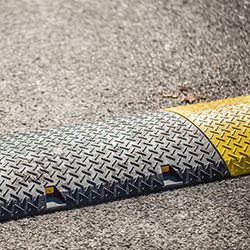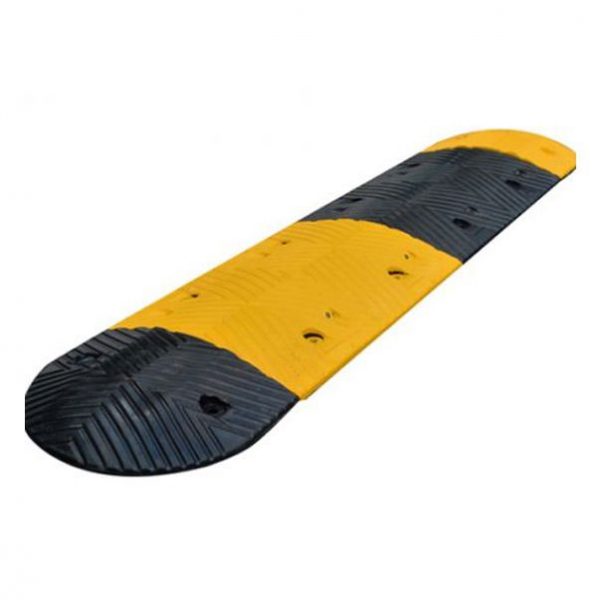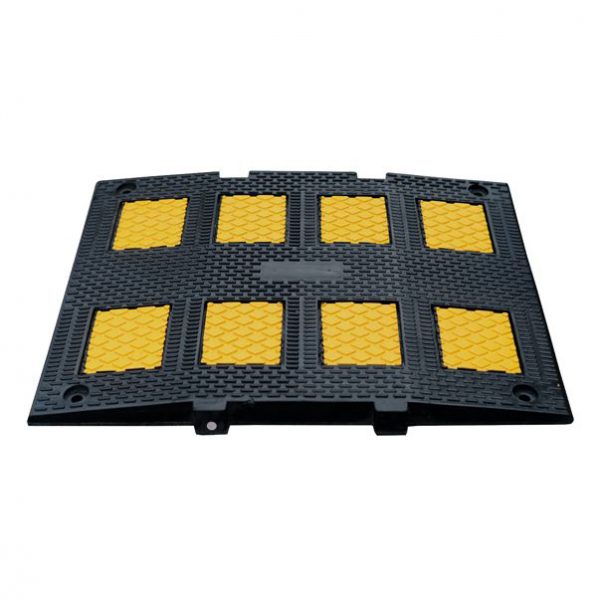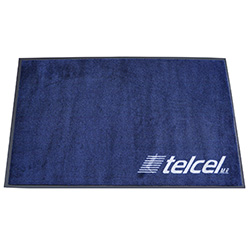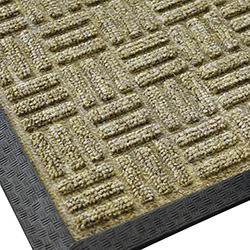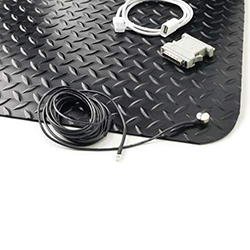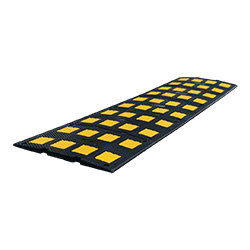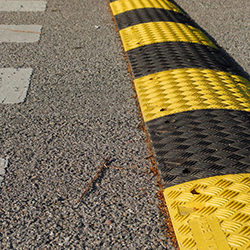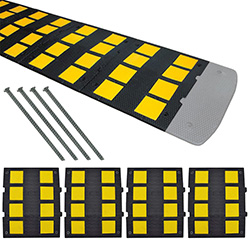Speed bumps are traffic calming devices that are used to reduce vehicle speeds in residential areas or areas with high pedestrian activity. While both speed humps and speed bumps serve the same purpose of slowing down vehicles, there are some key differences between the two. Speed humps are wider and have a gradual incline, allowing vehicles to pass over them at a higher speed. On the other hand, speed bumps are narrower and have a sharper incline, requiring vehicles to slow down significantly. The choice between speed humps and speed bumps depends on factors such as the desired speed reduction, the volume of traffic, and the specific road conditions. Ultimately, the goal of both speed humps and speed bumps is to enhance traffic safety and create a more pedestrian-friendly environment.

Standard Sizes
| SKU |
Description |
Length |
Height |
Width |
Weight |
Quantity 1- 49 |
Quantity 50+ |
| SB206FT |
6 Ft Speed Bump (1) 6′ Section With no End Caps |
72″ |
2″ |
12″ |
48.40 |
$74.98 |
$68.50 |
| SB207FT |
7 Ft Speed Bump (1) 6′ Section + (2) End Caps |
86″ |
2″ |
12″ |
55.40 |
$98.00 |
$92.50 |
| SB213FT |
Single Lane 12 Ft Speed Bump (2) 6′ Section With no End Caps |
144″ |
2″ |
12″ |
96.80 |
$173.96 |
$170.48 |
| SB219FT |
Double lane 19 Ft Speed Bump (3) 6′ Section + (2) End Caps |
230″ |
2″ |
12″ |
152.20 |
$285.94 |
$280.22 |
| SB225FT |
25 Ft Speed Bump (4) 6′ Section + (2) End Caps |
302″ |
2″ |
12″ |
200.60 |
$372.92 |
$365.46 |
| SB2ECAP |
End cap |
7″ |
2″ |
12″ |
3.50 |
$12.50 |
$12.50 |
For larger quantities please contact a representative for additional pricing discounts. 1-855-864-6281
Specifically designed to stop high speed traffic on streets and parking lots, Unimat rubber speed bumps are a smart solution to ensure a safe street and parking lot.
The rubber speed bumps are a smart investment since they don’t need any maintenance. Their rubber construction makes them last much longer than if they were made of other materials.
Use Unimat rubber speed bumps and take advantage of their outstanding features. They also have cat eye reflectors that allow them to be visible during night hours.
Features & Benefits of the rubber speed bumps
- Made of 100% recycled tire rubber, it is a flexible design; it fits on almost any highway surface to stop cars.
- Reflecting yellow ribbon.
- Cat Eye reflectors to optimize night vision and darkness vision.
- Pre-perforated for easy installing.
- Bottom with canals to help facilitate drainage, to set the wiring or street pipes.
- Our Speed bumps can be easily removed for storage or reinstalling.
- They can be used for temporary or permanent installation.
- Resistant to dampness, oil, temperature variations and ultraviolet rays.
- They won’t lose their shape, crack or get rotten.
- Flexible design allows them to adapt to inequalities of the road.
- Lightweight, they can be easily installed by only one person.
Speed bumps and speed humps are traffic calming devices designed to slow down drivers in certain areas. Speed bumps are made to slow drivers down to between 2 to 5 mph, while speed humps are designed to slow traffic on public roads such as schools. They are made of rubber and are durable and portable. You can find speed bumps and humps for sale online here.
Speed Bumps & Humps For Driveways & Parking Lots
There are several benefits of recycled plastic or rubber Speed Bumps and Speed Humps over regular and traditional asphalt or concrete bumps, and those specific benefits are:
- These speed bumps and humps are made out of 100% recycled material that contributes to the ecology.
- Thanks to their colored rubber material they never loose their color or brightness so you will never need to retouch the paint.
- Bumpers and humpers are light weight, easy to transport so it’s a simple one-person installation.
- Easy to remove for pavement maintenance or area maintenance, this helps to facilitate the job and eliminates time to every process.
- No maintenance needed.
- Effective costs because it has years of high performance with low maintenance. These low costs and low maintenance give the clients the opportunity to have a great product without affecting the company budget.
What’s the difference between a speed bump and a speed hump?
Speed Bumps are designed to improve pedestrian safety through slowing down vehicles in areas where slow speed is a must since it reduces the risk of accidents on residential street, driveways and parking lots. The average speed of a vehicle on a speed bump is between 2 to 5 mph.
Reinforce the stop signs in parking lots and roads and are made to slow down drivers to between 2 to 5 mph, this helps reducing accidents where you need to almost stop the vehicle in the area.
Speed Humps on the other hand, slow down vehicles to between 10 to 15 mph.
Slow traffic on public roads such as schools, hospitals, applies to where they need to reduce the speed but not stop a vehicle. Where emergency vehicles transit and they need to keep going. Industrial areas or areas with heavy truck traffic where high speeds can lead to an overturned vehicle or provoke an accident.
Yellow Recycled Plastic Speed Bumps
Our online store stocks several different lengths of speed bumps for sale from 6 to 25 inches for immediate shipment. You can combine bumps of different lengths to accommodate any width of parking lot or lane.
Choose from our wide variety of speed bumps. All Speed bumps have reflective yellow tape that help to increase safety in low light conditions.
Reflective Recycled Rubber Speed Bumps for sale
When we created our reflective recycled rubber speed bumps, we thought about creating an efficient product to improve the safety of pedestrians and motorists, that´s why we used the very best materials for manufacture and made sure we made the best shape and texture to improve its performance and endurance.
Our speed reducers are made of highly resistant recycled rubber with two installation holes and reflective yellow tapes that allow much greater visibility at any time of the day, while their one-piece construction notably increases their life time. The covers help for the drivers never notices that there is two parts of the Bump.
You can combine bumps of different lengths to accommodate any width of parking lot or lane.
Being much gentler than speed bumps, emergency vehicles don’t need to slow down as much as they do with Speed Bumps maintaining the safety of the areas where they are installed. They are highly visible and reflective.
We are sure that either our Speed Bumps or our Speed Humps will exceed all your expectations of quality and durability.
Color Guidelines
Importance of traffic safety
Traffic safety is of utmost importance in our communities. It ensures the well-being and protection of both pedestrians and drivers. By implementing effective traffic safety measures, such as speed humps and speed bumps, we can significantly reduce the risk of accidents and promote a safer environment for everyone. Speed humps and speed bumps serve as valuable tools in controlling vehicle speed and encouraging drivers to be more cautious. They help to prevent speeding and reckless driving, ultimately saving lives. With the increasing number of vehicles on the road, it is crucial to prioritize traffic safety to prevent injuries and fatalities. By understanding the importance of traffic safety and investing in appropriate solutions, we can create a safer and more secure transportation system for all.
Purpose of the article
The purpose of this article is to compare and contrast speed humps and speed bumps as traffic safety solutions. With the increasing concern for road safety, it is crucial to understand the differences between these two traffic calming measures and determine which one is more effective in reducing speeding and enhancing overall traffic safety. By examining their design, functionality, and impact on driver behavior, this article aims to provide readers with the necessary information to make informed decisions regarding the implementation of speed humps or speed bumps in their communities.
Differences between Speed Humps and Speed Bumps
Design and shape
When it comes to the design and shape of speed humps and speed bumps, there are some key differences to consider. Speed humps are typically wider and longer than speed bumps, creating a more gradual change in elevation. This design is intended to encourage drivers to slow down without causing significant discomfort or damage to vehicles. On the other hand, speed bumps are shorter and narrower, creating a more abrupt change in elevation. This design is often used in areas where a more aggressive traffic calming measure is needed. Ultimately, the choice between speed humps and speed bumps depends on the specific traffic safety needs of the area and the desired level of driver compliance.
Impact on vehicle speed
The impact on vehicle speed is a crucial factor to consider when comparing speed humps and speed bumps as traffic safety solutions. Speed humps are designed to slow down vehicles significantly, forcing drivers to reduce their speed. They are typically longer and have a gradual incline, allowing vehicles to pass over them at a slower pace. On the other hand, speed bumps are shorter and have a more abrupt rise, causing vehicles to slow down abruptly. While both speed humps and speed bumps effectively reduce vehicle speed, the difference lies in the extent of deceleration. Speed humps are more effective in reducing speed to a safe level, especially in areas where speeding is a major concern. However, speed bumps can be more suitable for areas where a temporary reduction in speed is required, such as near schools or pedestrian crossings. Ultimately, the choice between speed humps and speed bumps depends on the specific traffic conditions and safety requirements of the area.
Effectiveness in reducing accidents
When it comes to reducing accidents, both speed humps and speed bumps have proven to be effective traffic safety solutions. Speed humps, which are larger and wider than speed bumps, are designed to slow down vehicles more gradually, making them ideal for areas where speed reduction is a priority. On the other hand, speed bumps are smaller and steeper, causing vehicles to slow down abruptly. Both options serve as visual and physical reminders for drivers to reduce their speed, ultimately helping to prevent accidents and promote safer road conditions.
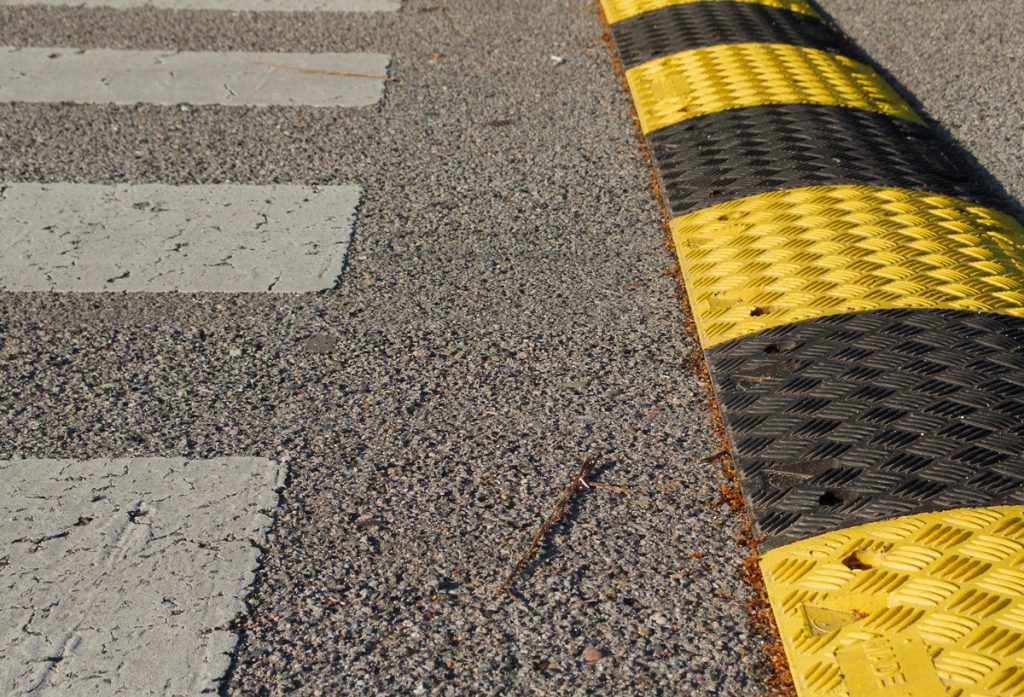
Advantages of Speed Humps
Slower vehicle speeds
Slower vehicle speeds play a crucial role in ensuring road safety and reducing the risk of accidents. Speed humps and speed bumps are both effective traffic calming measures that can help achieve this goal. Speed humps, also known as speed breakers, are elongated raised structures that are designed to slow down vehicles by forcing drivers to reduce their speed. On the other hand, speed bumps are shorter and more abrupt in shape, causing drivers to slow down significantly. Both speed humps and speed bumps are strategically placed in areas where speeding is a concern, such as residential neighborhoods, school zones, and parking lots. By implementing these traffic safety solutions, communities can promote a safer environment for pedestrians, cyclists, and motorists alike.
Improved pedestrian safety
Improved pedestrian safety is a crucial aspect of any traffic safety solution. Speed humps and speed bumps play a significant role in enhancing pedestrian safety by reducing vehicle speeds in areas with high foot traffic. These traffic calming measures force drivers to slow down, giving pedestrians more time to cross the road safely. Additionally, speed humps and speed bumps serve as visual cues for drivers, reminding them to be cautious and watch out for pedestrians. By implementing these measures, communities can create safer environments for pedestrians, reducing the risk of accidents and promoting a culture of pedestrian safety.
Reduced noise and vibration
Reduced noise and vibration is one of the key advantages of using speed humps as a traffic safety solution. Unlike speed bumps, which are known to cause significant noise and vibration when vehicles pass over them, speed humps are designed to minimize these disturbances. This is achieved through their gradual incline and longer length, which allows vehicles to smoothly transition over them without causing excessive noise or discomfort to drivers and passengers. By reducing noise and vibration, speed humps contribute to a quieter and more comfortable driving experience, making them an ideal choice for residential areas, school zones, and other locations where noise reduction is important.
Advantages of Speed Bumps
Greater vehicle speed reduction
Speed humps and speed bumps are both effective traffic calming measures that aim to reduce vehicle speeds in residential areas and other high-traffic zones. However, when it comes to achieving greater vehicle speed reduction, speed humps are generally considered to be the better solution. Unlike speed bumps, which are typically smaller and designed to create a jarring effect, speed humps are larger and wider, forcing drivers to slow down significantly. This is especially important in areas where excessive speeding poses a significant risk to pedestrians and other road users. By implementing speed humps, communities can create a safer environment and promote responsible driving habits, ultimately reducing the likelihood of accidents and injuries.
Clearer visibility
Clearer visibility is a crucial factor when it comes to ensuring traffic safety. Speed humps and speed bumps play a significant role in enhancing visibility on the road. By strategically placing these traffic calming measures, drivers are forced to slow down, allowing pedestrians and other road users to have a clearer view of the surroundings. This increased visibility reduces the risk of accidents and promotes a safer environment for everyone. Therefore, when considering the right traffic safety solution, it is essential to prioritize clearer visibility to ensure the well-being of all road users.
Lower installation cost
When it comes to comparing speed humps and speed bumps, one factor that stands out is the lower installation cost of speed bumps. Speed bumps are typically smaller and require less material and labor to install compared to speed humps. This makes them a more cost-effective solution for traffic safety. Additionally, the lower installation cost of speed bumps allows for wider implementation, making it possible to install them in more areas where traffic calming measures are needed. Overall, considering the budget constraints and the need for effective traffic safety solutions, speed bumps offer a favorable option with their lower installation cost.
Purpose of speed bumps
The purpose of speed bumps is to control and reduce vehicle speed in specific areas, such as residential neighborhoods, school zones, or parking lots. Speed bumps are designed to slow down drivers and promote safer driving habits, ultimately enhancing the overall safety of the community. By forcing drivers to reduce their speed, speed bumps help prevent accidents, protect pedestrians, and discourage reckless driving. They serve as a visual reminder for drivers to be more cautious and aware of their surroundings. Additionally, speed bumps can also help deter excessive noise and minimize traffic congestion in residential areas. Overall, the purpose of speed bumps is to create a calmer and safer environment for residents and pedestrians alike.
Importance of addressing community concerns
Addressing community concerns is crucial for fostering a harmonious and inclusive environment. It allows for open dialogue and understanding between residents and local authorities, ensuring that the needs and opinions of the community are taken into consideration. When it comes to speed bumps, addressing community concerns is especially important as it helps dispel any myths or misconceptions surrounding their effectiveness and impact. By providing accurate information and addressing concerns head-on, communities can work together to make informed decisions that prioritize the safety and well-being of all residents.
Myth: Speed bumps are ineffective in reducing speed
Research on the effectiveness of speed bumps
Research on the effectiveness of speed bumps has shown mixed results. Some studies have found that speed bumps can effectively reduce vehicle speeds and improve road safety. These studies suggest that speed bumps can be an effective traffic calming measure, particularly in residential areas or near schools where pedestrian safety is a concern. However, other research has raised concerns about the negative impacts of speed bumps, such as increased noise and vibration, potential damage to vehicles, and the possibility of diverting traffic to nearby streets. Therefore, while speed bumps can be an effective tool for reducing speeding and improving safety in certain situations, it is important to consider the potential drawbacks and weigh them against the desired outcomes before implementing them.
Benefits of speed bumps in reducing speed
Speed bumps are an effective tool in reducing speed and promoting safety in communities. One of the main benefits of speed bumps is their ability to slow down vehicles, forcing drivers to adhere to the designated speed limit. By creating a physical barrier on the road, speed bumps encourage drivers to be more cautious and attentive, reducing the risk of accidents and collisions. Additionally, speed bumps can help to calm traffic in residential areas, making the streets safer for pedestrians, cyclists, and children. Overall, the presence of speed bumps serves as a visual reminder for drivers to be mindful of their speed, ultimately contributing to a safer and more peaceful community.
Examples of successful implementation
Speed bumps have been successfully implemented in various communities around the world. For example, in the city of XYZ, speed bumps were installed in residential areas to address concerns about speeding vehicles. These speed bumps have effectively slowed down traffic and improved safety for pedestrians and residents. Similarly, in ABC town, speed bumps were strategically placed near schools and parks to ensure the safety of children and encourage drivers to adhere to the speed limit. The implementation of speed bumps in these communities has proven to be an effective measure in reducing accidents and promoting responsible driving.
Myth: Speed bumps cause damage to vehicles
Types of speed bumps that minimize vehicle damage
There are several types of speed bumps that are designed to minimize vehicle damage. One type is the flat top speed bump, which has a gradual incline and a flat top surface. This design helps to reduce the impact on vehicles and provides a smoother ride. Another type is the rubber speed hump, which is made of durable rubber material. It is designed to absorb the impact of vehicles and minimize damage. Additionally, there are speed cushions, which are wider than traditional speed bumps and have gaps between them. This design allows larger vehicles, such as buses and emergency vehicles, to pass over them more easily while still slowing down other vehicles. These different types of speed bumps help to address community concerns about vehicle damage while effectively controlling speed.
Proper installation and maintenance of speed bumps
Proper installation and maintenance of speed bumps play a crucial role in ensuring their effectiveness and addressing community concerns. When it comes to installation, it is important to consider factors such as the location, traffic volume, and speed limit of the road. Speed bumps should be strategically placed to slow down vehicles without causing unnecessary discomfort to drivers. Additionally, regular maintenance is essential to ensure that speed bumps remain in good condition and continue to serve their purpose. This includes inspecting for any signs of damage or wear, repairing any issues promptly, and keeping the surrounding area clean and free from debris. By adhering to proper installation and maintenance practices, speed bumps can effectively contribute to enhancing road safety and addressing the concerns of the community.
Studies on vehicle damage caused by speed bumps
Studies on vehicle damage caused by speed bumps have been conducted to assess the impact of these traffic calming measures. These studies have found that while speed bumps can cause minor damage to vehicles, such as scraping the underside or causing discomfort to passengers, the overall risk of significant damage is relatively low. In fact, speed bumps are designed to slow down vehicles and prevent accidents, which ultimately outweighs the potential for minor vehicle damage. Additionally, proper design and installation of speed bumps can help minimize any potential harm to vehicles. Overall, these studies provide valuable insights into the effectiveness and safety of speed bumps in addressing community concerns.
Myth: Speed bumps increase noise pollution
Factors contributing to noise pollution from speed bumps
Factors contributing to noise pollution from speed bumps include the design and construction of the speed bumps themselves. Poorly designed speed bumps can cause excessive noise when vehicles pass over them, especially if they are made of rigid materials such as concrete or metal. Additionally, the location of the speed bumps can also contribute to noise pollution. If speed bumps are placed in areas with high traffic volume, the constant braking and acceleration of vehicles can create noise disturbances for nearby residents. Furthermore, the speed at which vehicles approach and traverse the speed bumps can affect the level of noise generated. Higher speeds can result in louder impacts and vibrations, leading to increased noise pollution. It is important to consider these factors when implementing speed bumps to minimize noise pollution and ensure the well-being of the community.
Mitigation measures to reduce noise pollution
Mitigation measures to reduce noise pollution are crucial in addressing community concerns. One effective measure is the installation of sound barriers along roads and highways. These barriers can help absorb and deflect noise, significantly reducing the impact on nearby residents. Another approach is the implementation of traffic calming measures, such as speed bumps and roundabouts, which can help reduce noise levels by slowing down vehicles. Additionally, promoting the use of electric or hybrid vehicles can also contribute to noise reduction. By implementing these mitigation measures, communities can create a quieter and more peaceful environment for their residents.
Case studies on noise reduction techniques
In order to address community concerns regarding noise reduction, several case studies have been conducted to evaluate the effectiveness of different techniques. These studies have focused on various noise reduction methods, including the use of speed bumps. One such study found that strategically placing speed bumps in residential areas can significantly decrease noise levels caused by vehicles. By slowing down traffic and reducing the speed of vehicles, speed bumps can help create a quieter and more peaceful environment for residents. Additionally, other noise reduction techniques such as sound barriers and road surface modifications have also been explored in these case studies. Overall, the findings from these studies provide valuable insights into the effectiveness of different noise reduction techniques, including the use of speed bumps, in addressing community concerns.
Fact: Speed bumps improve pedestrian safety
Impact of speed bumps on pedestrian accidents
Speed bumps have been a topic of debate when it comes to their impact on pedestrian accidents. While some argue that speed bumps can effectively reduce the number of accidents by forcing drivers to slow down, others believe that they may actually increase the risk. Proponents of speed bumps argue that the physical presence of these road obstacles serves as a visual reminder for drivers to be cautious and attentive while driving through residential areas or areas with high pedestrian traffic. They argue that the reduction in vehicle speed can provide pedestrians with a safer environment, as it allows them more time to react to potential hazards. However, critics of speed bumps claim that these road features can lead to abrupt braking and acceleration, which may actually increase the likelihood of rear-end collisions and cause discomfort to passengers. Additionally, they argue that speed bumps can be particularly challenging for individuals with mobility issues, such as the elderly or those using mobility aids. Despite the ongoing debate, it is important to consider the specific context and characteristics of each location when assessing the impact of speed bumps on pedestrian accidents.
Benefits of speed bumps for vulnerable road users
Speed bumps have been proven to provide several benefits for vulnerable road users. One of the main advantages is that they help to reduce speeding, which is a common cause of accidents involving pedestrians and cyclists. By forcing drivers to slow down, speed bumps create a safer environment for these individuals, allowing them to navigate the roads with greater ease and confidence. Additionally, speed bumps can also act as a visual reminder for drivers to be more cautious and aware of their surroundings, further enhancing the safety of vulnerable road users. Overall, the presence of speed bumps can greatly contribute to the protection and well-being of pedestrians and cyclists, making them an effective tool in addressing community concerns.
Examples of how speed bumps enhance pedestrian safety
Speed bumps have proven to be an effective measure in enhancing pedestrian safety in various communities. For instance, in a residential neighborhood in City A, the installation of speed bumps has significantly reduced the number of speeding vehicles, ensuring a safer environment for pedestrians. Additionally, in a school zone in City B, the presence of speed bumps has encouraged drivers to slow down, preventing accidents and creating a safer crossing zone for students. These examples demonstrate the positive impact of speed bumps in addressing community concerns and promoting pedestrian safety.
Fact: Speed bumps can be designed to accommodate emergency vehicles
Design considerations for speed bumps and emergency vehicles
When designing speed bumps, it is crucial to consider the needs of emergency vehicles. Speed bumps should be designed in a way that allows emergency vehicles to safely navigate over them without causing any delays or damage. One important consideration is the height and width of the speed bumps. They should be designed to ensure that emergency vehicles can easily pass over them without any difficulty. Additionally, the placement of speed bumps should be carefully planned to avoid obstructing emergency vehicle access to important areas. By taking these design considerations into account, speed bumps can effectively address community concerns without compromising emergency response times.
Examples of speed bump designs that allow emergency vehicle access
Speed bumps are an effective traffic calming measure that can help reduce speeding in residential areas. However, one concern that is often raised is whether speed bumps hinder emergency vehicle access. Fortunately, there are speed bump designs that have been specifically developed to address this issue. These designs include features such as gradual inclines, wider widths, and strategically placed gaps to allow emergency vehicles to pass over them without any difficulty. By implementing these designs, communities can ensure that emergency vehicles can still navigate safely through the neighborhood while maintaining the benefits of speed bumps in controlling speeding.
Collaboration between emergency services and traffic engineers
Collaboration between emergency services and traffic engineers is crucial when considering the installation of speed bumps in a community. While speed bumps are effective in reducing speeding and improving road safety, they can also pose challenges for emergency vehicles. Therefore, it is essential for traffic engineers to work closely with emergency services to ensure that the placement and design of speed bumps do not hinder their response time. This collaboration involves conducting thorough assessments of emergency access routes and considering alternative traffic calming measures that do not impede the movement of emergency vehicles. By working together, emergency services and traffic engineers can strike a balance between enhancing community safety through speed bumps and ensuring the prompt and efficient delivery of emergency services.

